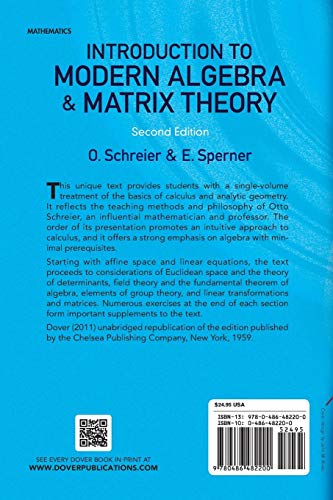



Introduction to Modern Algebra and Matrix Theory: Second Edition (Dover Books on Mathematics)
G**Y
a mix of concrete and abstract, elementary and advanced
The Mathematical Association of America: "more accurate to characterize this wonderful book as a thoroughgoing rendering of linear algebra at a concrete level," and The Mathematics Teacher: "Outstanding...good introduction...each topic is painstakingly developed." This is an unusual textbook. No calculus here, yet, a dose of mathematical maturity presupposed in order that a student will benefit most from its content. We begin elementary enough: points, lines, planes, then to hyper-planes. First chapter, linear equations given ample discussion through interplay of geometry and algebra. Note well that chapter one paves the way for the remainder of the entire text. Concrete and abstract always intertwined seamlessly. This initial chapter, some fifty pages, contains some twenty theorems and their proofs. Throw in student-exercises which accompany each section, copious diagrams and and one views dense thicket of information. If chapter one proceeds with little issue, I claim that the entirety of the text is within student's grasp. Second chapter--a favorite--is Determinants. Progressing from length, to scalar product, to area, to volume, one seeks the all important "...function which assigns to any set of n-vectors a uniquely determined real-functional value with the following properties...." (page 68). Elaboration of these properties ensues for well over a hundred pages, with fine discussion of rigid motion. A highlight is the elaboration of rigid motions in the plane and three-space (pages 153-178) and a pretty proof "...that if the determinant is 'positive one,' the dimension of the vector space is either one or three (it cannot be two)..."Third chapter: Fields and the Fundamental Theorem of Algebra. Read: "We remove the restriction that our symbols represent Real Numbers." Elementary field theory followed by polynomials, complex numbers, onward to the fundamental theorem. In fact, Pages 218-228 give a fine abstract (yet elementary !) presentation of the 'field of complex numbers' concluding with ten pages of meaningful discussion around the fundamental theorem of algebra. An excellent conclusion to an excellent chapter. Finite groups in the next chapter: brief and lucid (axioms, subgroups, abelian); Read: "Aside from these considerations, an important reason for our discussion was that it enabled us to introduce ideas and methods whose generalizations will be very important for the theory of matrices in the next chapter." Groups are discussed as prelude to linear transformations and matrices: "We shall now concern ourselves with certain sub-spaces which are mapped into themselves" begins the wonderful exposition of invariant subspaces (nullspace, decompositions, geometric interpretation, unitary and orthogonal transformations) taking one to the end of the text, and the " illustration of when a matrix can be transformed into one which has only zeros on one side of the main diagonal." A most satisfying and rewarding excursion. From elementary to advanced, from concrete to abstract. Some of the exercises are computational (concrete), others ask for the complete proofs (abstract) ---thus, not entirely elementary. If the requisite mathematical maturity is possessed (or, acquired along the way) all will be accessible to an undergraduate student.A superb companion, highly recommended.
Trustpilot
1 month ago
1 day ago